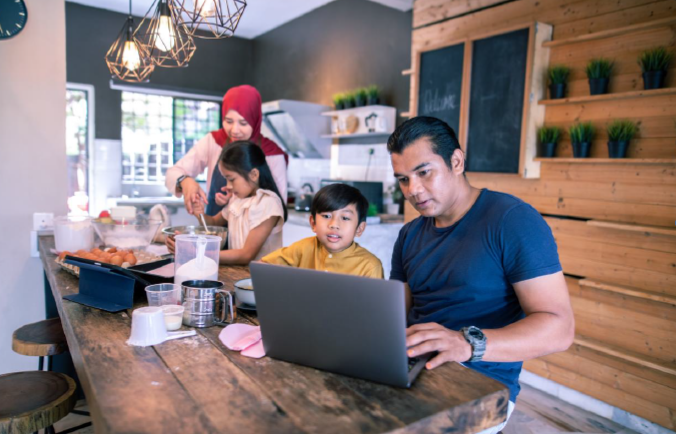Written by Li-Hsian Choo

Source: iStock
As parents, most of us would never leave our young children unattended in a crowded physical space where known predators and paedophiles potentially lurk. Yet, many parents think nothing of leaving their children unattended in similar spaces online. Aside from these external threats to our children’s safety, excessive screen time also has negative effects on a child’s development as well as their overall health and well-being. We need to understand how tech is changing childhood and educate ourselves on how we can support and safeguard our children who are surrounded by screens on a daily basis, sometimes without appropriate supervision.
Screens are Changing Childhood
Screens are changing childhood in ways we cannot even imagine. Over the last 20 years, there has been an explosion of media and technology. Children have been at the centre of these drastic digital developments that have changed nearly everything about how they connect, learn, and grow up. Childhood is no longer “play-based”, it is “phone-based”. As Liz Perle, Founding Editor-in-Chief of Common Sense Media (more on this organisation later), said in 2006, “We are conducting the world's greatest experiment on our kids in real-time - and we don't know how it's going to turn out.”

Source: www.anxiousgeneration.com
More recently, The Anxious Generation, a book written by American social psychologist and New York University professor Jonathan Haidt, inferred that the modern smartphone was a “pocket full of poison”. The book is an urgent and persuasive warning about the toll of “phone-based childhoods”. He believes that the growing mental health crisis gripping teens and college students in the US (a trend also seen globally) has been driven by the mass adoption of smartphones, along with the proliferation of social media and addictive online gaming. Haidt calls this “The Great Rewiring of Childhood” and has emphasised that “the environment in which children grow up today is hostile to human development.”
Haidt added, “We have overprotected our children in the real world and under-protected them online. I call smartphones ‘experience blockers’ because once you give the phone to a child, it’s going to take up every moment that is not nailed down to something else. That means that there will be very little other experience other than through the phone. It’s basically the loss of childhood in the real world.”
He also pointed out that “children are spending less time socialising in person and more time stuck to their screens, with girls most likely to be sucked into the self-esteem crushing vortex of social media, and boys more likely to become hooked on gaming and porn.”
A review of Haidt’s book in The Guardian also shared Haidt’s belief that “Parents have become overprotective in the offline world, delaying the age at which children are deemed safe to play unsupervised or run errands alone, but do too little to protect children from online dangers. We have allowed the young too much freedom to roam the Internet, where they are at risk of being bullied and harassed or encountering harmful content, from graphic violence to sites that glorify suicide and self-harm.”
A rather alarming opinion piece written by Jessica Grose for the New York Times recently highlights the overreliance of education today on devices and shares that teachers are today in constant battle mode at school. They need to fight for their students’ active attention (because kids’ brains are now hard-wired for instant gratification by TikTok and YouTube) and also make sure kids are not accessing inappropriate sites. She also “heard about kids disregarding teachers who tried to limit tech use, fine motor skills are atrophying because students rarely used pencils and children whose learning was ultimately stymied by the tech that initially helped them - for example, students learning English as a second language becoming too reliant on translation apps rather than becoming fluent.”
She adds, “Some teachers said they have programs that block certain sites and games, but those programs can be cumbersome. Some said they have software, like GoGuardian, that allows them to see the screens of all the students in their classes at once. But classroom time is zero sum: Teachers are either teaching or acting like prison wardens; they can’t do both at the same time.”
The same piece quotes Holly Coleman, a parent of two who lives in Kansas and is a substitute teacher in her district. Holly describes what students are losing in a manner most parents and teachers can probably relate to: “They can type quickly but struggle to write legibly. They can find info about any topic on the Internet but can’t discuss that topic using recall, creativity or critical thinking. They can make a beautiful PowerPoint or Keynote in 20 minutes but can’t write a three-page paper or hand-make a poster board. Their textbooks are all online, which is great for the seams on their backpack, but tangible pages under your fingers literally connect you to the material you’re reading and learning. These children do not know how to move through their day without a device in their hand and under their fingertips. They never even get the chance to disconnect from their tech and reconnect with one another through eye contact and conversation.”
Focus More on What Children are Consuming, Less on Hours Logged

Source: iStock
The acceptable amount of screen time, as previously recommended by the American Academy of Paediatrics (“AAP”) and commonly quoted in a lot of parenting literature, used to call for:
- No screen time for children under 2 years
- One hour per day for children 2 to 12 years
- Two hours per day for teens and adults
The AAP subsequently updated its media use recommendations in 2016, saying, “It can be tempting to want a set number of hours on screens that is “safe” or healthy to guide your family’s technology use. Unfortunately, there isn’t enough evidence demonstrating a benefit from specific screen time limitation guidelines. These evidence-based guidelines do not give a set screen time limit that applies to all children and teens. Because children and adolescents can have many different kinds of interactions with technology, rather than setting a guideline for specific time limits on digital media use, we recommend considering the quality of interactions with digital media and not just the quantity, or amount of time.”
“It is important to consider the specific activities that children and teens engage in on social media, and to support them in using social media in ways that strengthen their social, emotional, cognitive and identity development. When it comes to household rules around technology use, there is evidence that rules focusing on content, co-viewing and communication are associated with better well-being outcomes than rules focused on screen time,” the AAP added.
A More Thoughtful Approach is Needed from Parents

Source: iStock
Thus, today's parents may sometimes need to change their mindsets and take a more thoughtful approach to complement direct screen time management and control. As parents, we need to re-educate ourselves on digital health and safety in this rapidly evolving media environment, so we can support our children better.
The AAP has recommended several resources published by Common Sense Media, and other credible media-related sources that parents should refer to:
- “How Much Screen Time is OK for My Kids?” that emphasises how quality of media use is more important than setting screen time limits.
- “Are Some Types of Screen Time Better Than Others?” hat provides guidance on assessing the quality of a child’s digital media use.
- “Beyond Screen Time: Help Your Kids Build Healthy Media Use Habits” is another useful article with a video and comprehensive chart offering a good overview and guidance on this topic.
- Healthychildren.org recommends and offers a good online tool for creating a customised Family Media Plan to facilitate discussion around safe and practical media use that works for each family’s specific needs. This plan lets you set consistent expectations and limits on media use for your kids, helping them balance media use with other healthy activities. Share your family’s media rules with caregivers, grandparents, and other family members who play a part in your children’s daily lives to help ensure rules are enforced consistently. You can also complement this by signing a pledge as a family.
As parents, we need to educate ourselves on the digital platforms that our children like to engage with to assess their appropriateness and implement good parental controls where required. We should frequently check on our children’s media use for their health and safety. For example, we need to ensure that the people they play games with or talk to online are people actually known to them and, preferably, also to us. Local online parenting magazine, makchic.com has published some useful parental guides to some popular gaming and social platforms, such as:
- Gaming 101: A Parent’s Guide to Roblox, Minecraft and Fortnite
- A Parental Guide to TikTok
- A Parent’s Guide to Instagram’s New Parental Supervision Tools

Source: iStock
We need to have meaningful conversations with our children, especially our tweens and teens, about their media use, good digital citizenship and online safety. Tweens and teens are more likely to have some independence in what they choose and watch, and they may be consuming media without parental oversight. Talk to them honestly and regularly about what they have seen or read, who they are communicating with, and what they have learned from their media use. Common Sense Education also provides tips, discussion prompts, and activities for families to learn about digital citizenship together. As a family, it is also good to discuss how to avoid (and manage) serious issue like cyberbullying and sexting. Children should also be made aware of the dangers of online solicitations and grooming as well as how to safeguard their privacy. makchic.com has another good article with tips on how to keep your teens safe online. That said, we should also educate our younger children while they are little and instill in them good habits before they turn into sullen tweens or teens.
Read Part 2 here for more tips on helping your children build a safer and healthier relationship with screens!















![[St. Joseph’s Institution International School Malaysia] The Lasallian Education Ethos for a Better Future - Gratitude and Giving](https://mint-edm.sgp1.digitaloceanspaces.com/production/PPIxso2IiVm1U64SEHCuXjI03yE7Rg.jpeg)




















